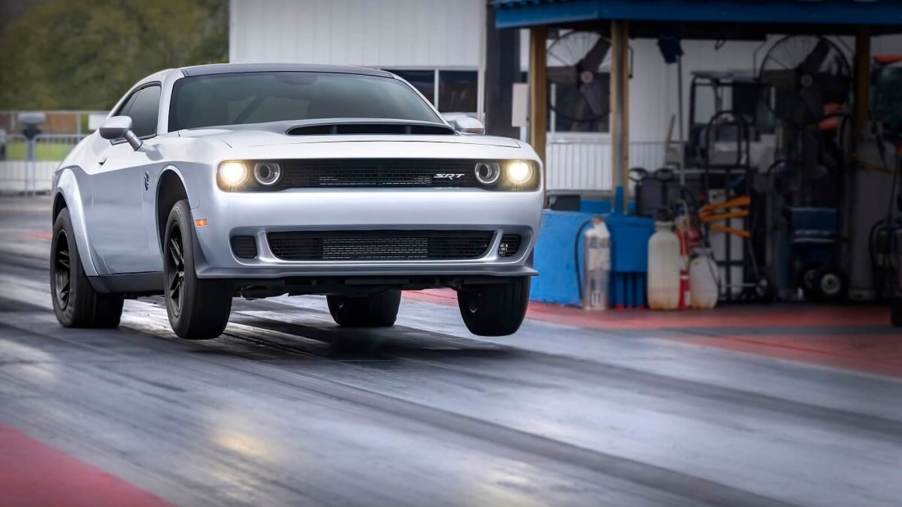
What’s the Difference Between a Dodge Challenger and a Dodge Charger?
When it comes to affordable muscle, it’s tough to top the Dodge Challenger and Dodge Charger. That’s partially why the Hellcat versions of these cars were named Autotrader’s Car of the Decade. And despite their age, both are surprisingly popular and daily-drivable. But there are a few differences between the two.
Dodge Challenger vs. Charger: practicality
The most obvious difference between the Dodge Challenger and Charger is the number of doors. Although they share the same 90s-Mercedes-Benz-derived platform, the Charger is a 4-door sedan, while the Challenger is a 2-door coupe. The ability to comfortably carry more people is likely the reason why the Charger out-sold the Challenger in 2019. The Charger is also longer than the Challenger and has more interior room.
That’s not to say the Challenger is cramped. I drove one for a few days around Detroit, and I can honestly say I was not challenged for space. Then again, I was alone in the car. And the Challenger’s back seat is definitely less spacious than the Charger’s and more difficult to access. In addition, the Charger’s trunk lid opens farther, and closes more easily, than the Challenger’s. The sedan’s trunk also has a wider opening, making loading and unloading easier.
That being said, in some ways, the Dodge Challenger is just as practical. YouTuber RP Productions reports the Charger scrapes against inclines more often the Challenger. And, just like the Charger, the Challenger is available with all-wheel drive in some trims. However, the Challenger can pair AWD with two trims, the SXT and GT, while only the Charger SXT gets AWD.
In addition, although The Drive reports Dodge is now the most reliable American brand, Consumer Reports found the Challenger is actually more reliable than the Charger. As with the Toyota 4Runner, Dodge has been making both cars so long, most of the kinks have been ironed out.
It’s not clear exactly why the Challenger is more reliable than the Charger. It may be similar to why the Tahoe is more reliable than the Suburban: the larger vehicle sees more use, and therefore abuse.
Dodge Challenger vs. Charger: performance
As Autoweek explains, part of the Charger’s appeal is the combination of 4 doors with high-powered engines. Dodge claims the 707-hp Charger Hellcat Widebody is the fastest production sedan, topping out at 196 mph. But, if you’re after maximum performance, the Dodge Challenger arguably has the advantage. At least on paper.
For one, RP Productions notes the Challenger Hellcat’s seats are more supportive and sportier than the Charger’s. The Challenger Hellcat also has 10 more hp than the Charger version, and you can get it with a manual. Lastly, although you can’t get a Demon anymore, it’s the Challenger that provides the next-best thing, not the Charger. That’s the Dodge Challenger Hellcat Redeye Widebody, which comes with 797 hp. Here, though, as with the Charger Hellcat, the only transmission is an 8-speed automatic.
However, in the real world, the Dodge Challenger and Charger are equally quick. Car and Driver found both cars’ 5-60 times (the better real-world acceleration comparison) are the same: 4.1 seconds. And although the Widebody versions of both cars, which offer wider tires, do measurably improve their handling, Car and Driver found the Charger’s slightly-softer suspension and added length made it more stable.
Which should you buy?
In terms of outright cost, the Dodge Charger is only slightly more expensive than the Challenger.
In base SXT RWD trim, the Charger starts at just under $30k, while the Challenger stickers at just under $28k. Jumping up to the Hellcat Widebody trim, the Challenger is about $66.7k, while the Charger starts at $71.7k. Regardless of trim, though, both offer the same infotainment and driver-assistance options.
Ultimately, choosing between the Dodge Challenger and Charger depends on what you’ll use your car for. If you’re after retro style and want the satisfaction of 797 hp, the Challenger is the one for you. But if you want more practicality, the Dodge Charger is the better buy, and just as fast on the street.


